Best Foods for Gut Health
Many factors, including the foods you eat, can impact the type of bacteria found in your digestive tract. Your gut relies on just the right balance of different bacteria to digest your food and to prevent infection and inflammation. They’re incredibly important for your health. Gut health also affects your mental health, weight, blood sugar, and liver.
The secret to good gut health doesn’t have to be about following a really complicated diet, shopping in specialty stores, or relying one expensive probiotic supplements. You can improve your gut health by simply incorporating a variety of more beneficial foods.
What you eat directly influences the makeup of bacteria in your gut—known as the microbiome—which in turn impacts your health. A healthy gut helps keep chronic diseases like heart disease and cancer at bay, and also can reduce inflammation, keep your brain healthy and help you maintain a healthy weight. It’s never too late to change your diet to support better bugs in your gut. Research shows that making different dietary choices can change the makeup of your microbiome in as little as 24 hours.
With so much information online about healthy eating, it can be tricky to be sure about what’s best for a healthy gut, so here’s a list of some foods that will put you on the path for better gut health.
Probiotic foods contain living microorganisms like the health-promoting microbes found in your gut. Eating probiotic foods can help boost your body’s population of beneficial bacteria.
Common bacteria groups found in probiotic foods include Lactobacillus and Bifidobacterium. Probiotic foods are made by adding microbes to food and/or allowing a process known as fermentation to take place. In addition to helping balance your gut bacteria, probiotics can help if you have diarrhea, boost your immunity and keep your heart and skin healthy
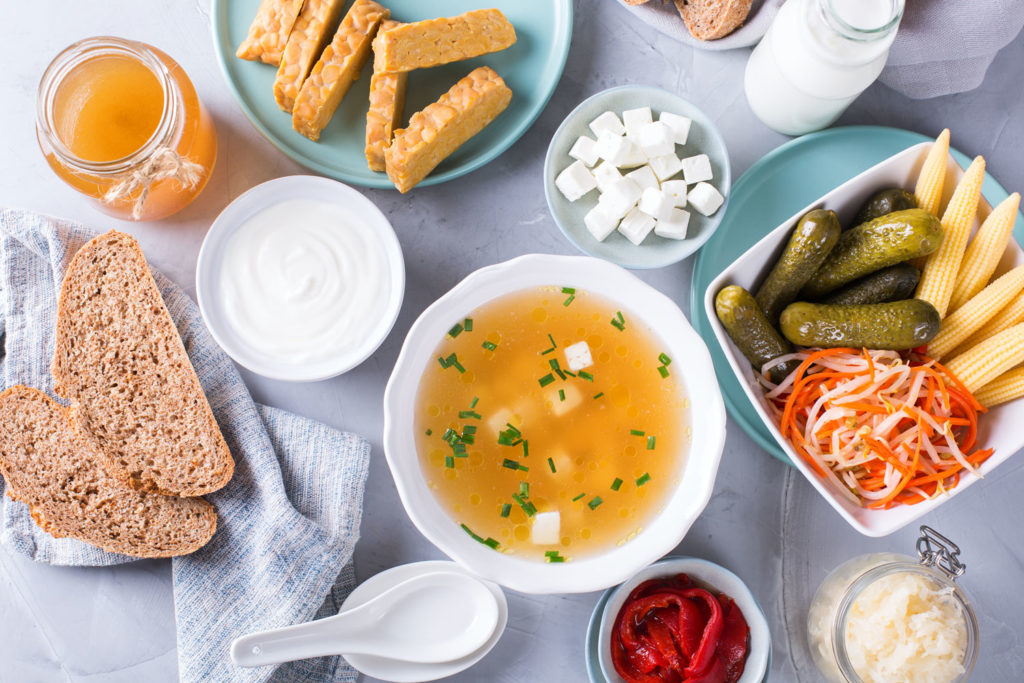
Probiotic Foods
Examples of probiotic foods include:
Tempeh
Tempeh is similar to tofu in that it’s made from soybeans, but unlike tofu, tempeh is a fermented food, so it contains probiotics. Tempeh is made when soybeans are fermented and then pressed into a cake. It can then be grilled, sautéed or baked. Tempeh is high in protein, making it a good option for vegetarians and vegans. It’s also packed with B vitamins, calcium, manganese, zinc and copper.
Miso
Miso is a fermented paste made from soybeans, barley or rice. Similar to other fermented foods, beneficial bacteria are produced in the fermentation process. You’ll also get some protein if you eat miso made from soybeans. A little bit goes a long way, which is good since miso is also high in sodium.
Kefir
Kefir is like drinkable yogurt. It’s made when kefir grains, which are colonies of yeast and lactic acid bacteria, ferment the sugars in milk, giving it a slightly thicker consistency and tart flavor. Similar to yogurt, kefir is packed with probiotics.
Buy plain kefir (instead of flavored) to skip added sugars. Due to fermentation, kefir has a slightly tart and acidic taste, which makes it tasty added to a breakfast smoothie instead of milk. Or try substituting kefir for milk in overnight oats for a healthy combo of probiotics and fiber.
Kimchi
Kimchi, also fermented cabbage, is the spicy Korean cousin to sauerkraut. It can have scallions, radishes and shrimp added to give it more flavor. Look for it in the refrigerated section near sauerkraut, other Asian sauces and pickles.
Kombucha
Kombucha is a tart, fizzy tea made by adding a SCOBY (symbiotic colony of bacteria and yeast) and sugar to green or black tea. It’s then fermented for a week or more. During fermentation alcohol and gases are produced, giving the kombucha natural carbonation. The amount of alcohol is usually less than 0.5% alcohol by volume (although some have been found to have closer to 2-3%).
Additionally, acetic acid and lactic acid bacteria are produced, the latter of which is known to function as a probiotic. When consuming kombucha made from green tea, you’ll also get the antioxidant properties associated with tea. Keep in mind that some kombuchas, like those made from black tea, contain caffeine. Others have artificial sweeteners, which can negatively alter gut bacteria, so read labels.
Sauerkraut
Sauerkraut is made from cabbage and salt. During the fermentation process, microorganisms eat the sugar present in cabbage and produce carbon dioxide and acids. The probiotics created during fermentation assist with digestion and add good bugs to your gut.
One cup of raw cabbage has 36% of your Daily Value for vitamin C and 56% DV for vitamin K.
Yogurt
Yogurt is probably the most popular probiotic and for good reason. It’s made when good bacteria are added to milk, where they metabolize lactose to form lactic acid and other beneficial bugs. Look for yogurt labeled with the “Live & Active Cultures” seal, which guarantees 100 million probiotic cultures per gram. A quick look at the ingredients list will also show you if there are bacteria in the yogurt. Don’t eat dairy? The probiotics in yogurt help digest some of the lactose (milk sugar) so if you’re lactose-intolerant, you may be able to enjoy yogurt. Plus, many companies now make dairy-free and vegan yogurts that contain probiotics.
When choosing probiotic foods, check labels for live, active cultures, which indicates the bacteria in the foods are still living. For instance, when shopping for probiotic sauerkraut, reach for refrigerated brands with live cultures. Shelf-stable, pasteurized sauerkraut in a can or a jar—the type of sauerkraut your mother may have bought as a hotdog condiment—is unlikely to contain living microbes. Living microbes are beneficial because they join the community of living microbes already in your gut.
Probiotics are also available in over-the-counter dietary supplements. However, there’s mixed evidence of their benefits, and the American Gastroenterological Association (AGA) does not recommend the use of probiotic supplements for most digestive conditions. If you do choose to take probiotic supplements, the AGA suggests that you do so with a doctor’s guidance.
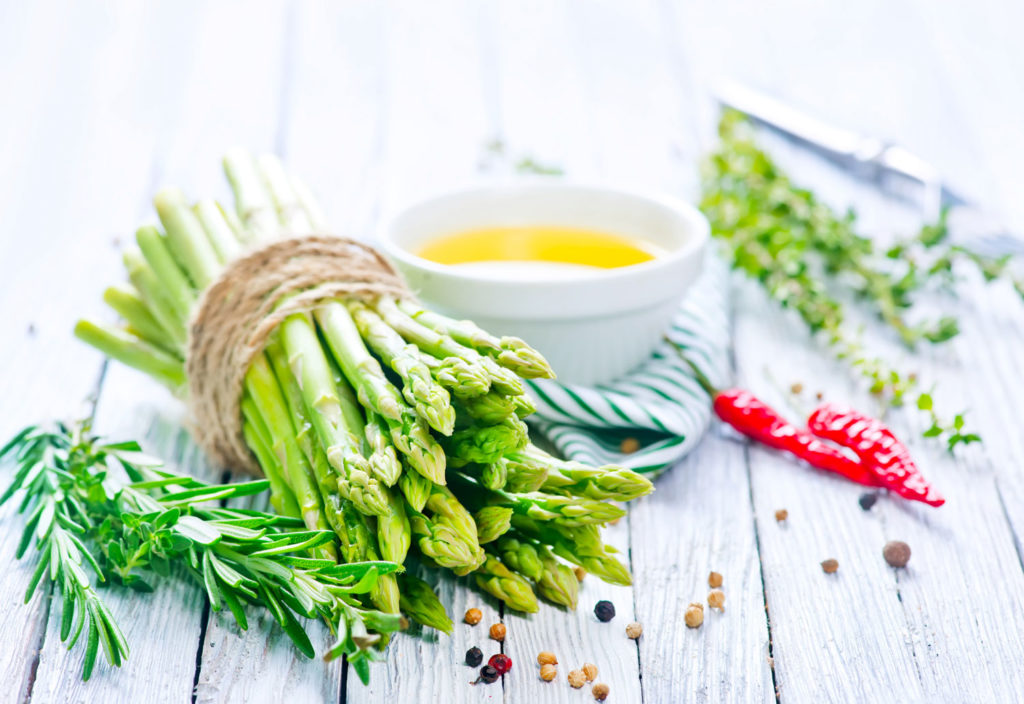
Prebiotic Foods
It’s not enough to eat plenty of probiotic-rich foods—you also have to eat foods that help keep these health-promoting microorganisms alive.
That’s where certain types of soluble fiber called prebiotics come in. Prebiotics are fibers that feed the beneficial probiotics in your gut, which helps keeps your gut in balance.
Good prebiotic foods include:
Asparagus
Not only is asparagus a powerful prebiotic for the gut, it may also be protective against certain cancers. This is because it contains glutathione, an antioxidant that fights off free radicals and other inflammatory compounds in the body.
Roasted asparagus can be made in just 15 minutes—simply toss the spears with olive oil, salt and pepper and oven-roast at 400°F for 10 to 15 minutes. Or shave raw asparagus over a green salad. Asparagus is also delicious added to pasta or an omelet.
Bananas
Green bananas (the unripe ones) are best for the gut because they contain resistant starch, a type of indigestible fiber that produces more good bugs when your microbes feed on it. Resistant starch can also be created by cooking grains and then cooling them. So go ahead and make barley in bulk for the week. Ripe bananas are full of fiber too.
Eat bananas with peanut or almond butter for fiber, protein and healthy fat. Or add to overnight oats, Greek yogurt or a high-fiber cereal, or top whole-wheat toast.
Pears
Pears are a prebiotic food for the gut but also contain pectin, a compound that helps lower cholesterol. One medium pear is just 100 calories but has 5.5 grams of fiber.
Add a dash of cinnamon to fresh pear slices for a tasty snack, bake a pear crisp, or mix diced pear into oatmeal for additional health benefits. The fiber in oatmeal, known as beta-glucan, helps lower cholesterol.
Watermelon
Watermelon is naturally high in prebiotics with 1 gram of fructan per cup. One cup also has 14% DV for vitamin C, an antioxidant that fights inflammation, is the building block of collagen and increases the absorption of iron.
Watermelon is a summer staple that is tasty eaten plain. Find that boring? Make a refreshing beverage or combine with feta and mint for a summery salad.
Chicory
Chicory root comes from a flowering plant in the dandelion family. It’s popular for its coffee-like flavor and has historically been used in cooking and medicine.
Approximately 68% of chicory root fiber comes from the prebiotic fiber inulin, a fiber that feeds and promotes the growth of healthy probiotic bacteria in our guts. Chicory root has a mild laxative effect, increases bile from the gallbladder, and decreases swelling. Chicory is a rich source of beta-carotene.
Garlic
Think food-as-medicine when you cook with garlic. Garlic may help reduce the risk of heart disease and is also anti-inflammatory in the body. Inulin and fructooligosaccharides are the two main fibers in garlic—a dynamic prebiotic duo.
Don’t be afraid of buying whole garlic. Simply buy a garlic press and you can put the whole clove in there without having to peel it (yes, please). Garlic can be used to season almost any dish. Sauté it with onions and mix into a stir-fry or pasta.
Jerusalem artichokes
Also known as sunchokes, Jerusalem artichokes have 47 grams of fructans in 1 cup (regular artichokes clock in with just 6 grams per ‘choke). One cup also delivers 3 grams of protein, 2.4 grams of fiber, 25% DV for thiamin, and 28% DV for iron. The majority of carbohydrates in ‘chokes are inulin, a prebiotic fiber that provides food for your critters. Thiamin (a B vitamin) supports healthy hair, skin and nails, and iron helps form red blood cells.
Try sunchokes roasted with olive oil and garlic, raw in salads (they have a texture similar to water chestnuts)
Leeks
One leek has 10 grams of good-for-the-gut fructans, and 1 cup has 35% DV for vitamin K and 12% DV for vitamin C. Vitamin K helps your blood clot, and vitamin C is an antioxidant.
Leeks can be added to almost any dish—try adding them to an omelet or sautéing them to mix with roasted potatoes. Alternatively, rub whole leeks with oil and grill briefly; then toss with your favorite vinaigrette.
Onions
Onions are chock-full of inulin, fructans and fructooligosaccharides. Not only are FOSs a prebiotic that help build up gut flora, they also help lower cholesterol and relieve constipation.
Onions are highly versatile: add to soup or salad, grill and put on top of a turkey burger, or roast with herbs and serve as a side.
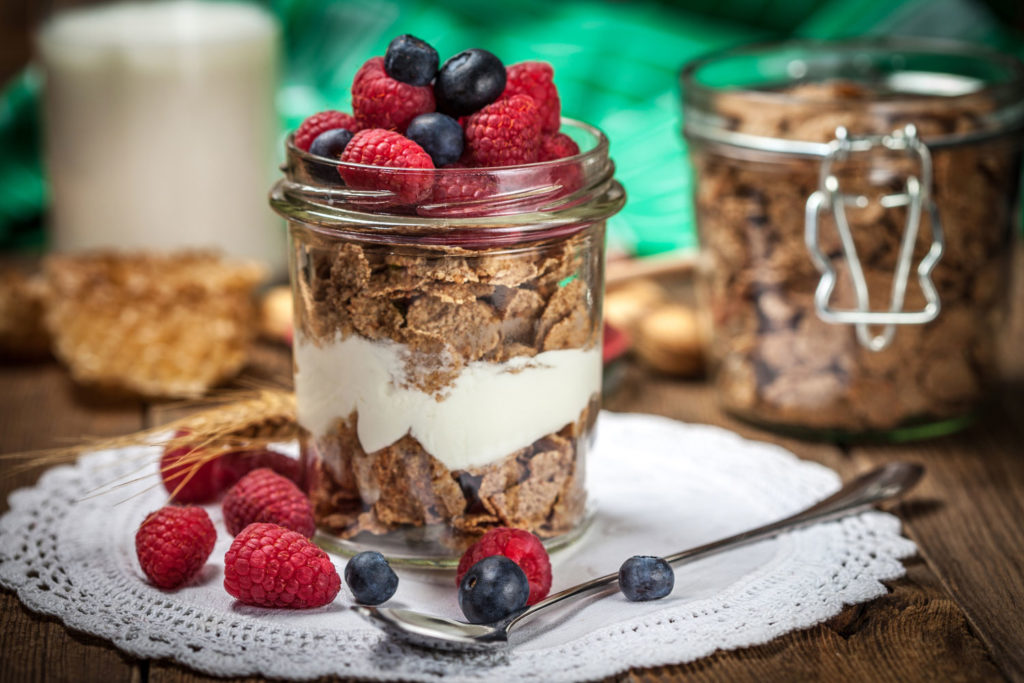
Synbiotic Foods
Synbiotic foods combine prebiotics and probiotics into a single, uber-healthy gut microbe-supporting meal. These foods provide the pros of prebiotics and probiotics at once, supporting existing gut bacteria and delivering additional living cultures to your gut.
Some examples of synbiotic foods include:
- A banana smoothie made with kefir or yogurt
- Stir-fry made with tempeh, asparagus, garlic and leeks
- Yogurt with blueberries
To make these foods even better for your gut, add high-fiber ingredients, such as whole grains, nuts, seeds, vegetables, fruits or legumes.
Polyphenols
Polyphenols may help prevent blood clots, reduce blood sugar levels, and lower heart disease risk. They may also promote brain function, improve digestion, and offer some protection against cancer, though more research is needed.
Rich in fiber and plant-based molecules known as polyphenols, travel into your intestines where microbes use them for fuel. Foods that are rich in polyphenols, such as dark chocolate, have anti-inflammatory properties, decrease blood pressure and cholesterol levels and decrease cellular stress.
Who needs a reason to eat more chocolate? Count me in!
What are some other foods to improve your gut that are rich in polyphenols?
Red grapes & wine made from red grapes
Grapes may be one of the most versatile fruits. Besides being delicious eaten out of hand, they also give us wine, raisins, and jelly. As a bonus, they contain powerful antioxidants.
Grapes, grape juice, and wine have antioxidants that help the cardiovascular system. These antioxidants, sometimes called flavonoids or polyphenols, can relax blood vessels and reduce inflammation. They also reduce the clotting function of platelets much as aspirin does.
Grapes, grape juice, and wine have antioxidants that help the cardiovascular system. These antioxidants, sometimes called flavonoids or polyphenols, can relax blood vessels and reduce inflammation. They also reduce the clotting function of platelets much as aspirin does. These antioxidants reside mainly in the skin and seeds of grapes.
Almonds
Several recent studies have revealed that almonds may possess powerful probiotic properties. The nuts have been shown to increase levels of good bacteria in the gut, thanks to their high fibre content, and may even decrease levels of microbes that cause food poisoning.
Onions
Onions are chock-full of inulin, fructans and fructooligosaccharides. Not only are FOSs a prebiotic that help build up gut flora, they also help lower cholesterol and relieve constipation.
Onions are highly versatile: add to soup or salad, grill and put on top of a turkey burger, or roast with herbs and serve as a side.
Green tea
By increasing counts of beneficial bacteria in your microbiome, you also help to push out bad bacteria (kick them out of their parking spaces). Overall, drinking probiotic tea can help to rebalance your gut microbiome and improve your digestive health, and that leads to a series of benefits that significantly lower the risk of obesity.
Blueberries
Blueberries are palatable fruits with one of the highest antioxidant contents to be found. … Blueberry polyphenols have been shown to enhance neuroprotection through molecular mechanisms involving, beyond a radical scavenging activity, the counteraction of β-amyloid toxicity, neuroinflammation, and excitotoxicity.
Raspberries
One cup of raspberries has a whopping 8 grams of fiber, about one third of your Daily Value. Raspberries are a rich source of polyphenols, potent antioxidants that your gut microbes love to nosh.
Raspberries are delicious eaten fresh but are just as nutritious purchased frozen and thrown into a smoothie. Or add them to yogurt, oatmeal or a high-fiber cereal.
Broccoli
With its relatively mild flavor, versatility, and affordability, broccoli provides an accessible and delicious way to give your body a brassica boost. For starters, the fiber in broccoli is an excellent prebiotic, which means it provides the perfect nutrition for your friendly gut microbes to thrive.
The research suggests that cruciferous vegetables — such as broccoli, Brussels sprouts, and cabbage — contain an organic chemical compound that helps maintain gut flora and immune surveillance. This may help prevent various cancers and Crohn’s Disease, caused by gut inflammation.
Cocoa
Cocoa beans are actually seeds from the Theobrama cacao tree. Not only are they used to make chocolate, but they’re delicious and healthy.
Cocoa powder, created by crushing cocoa beans and removing the fat or coca butter, makes it easy to add cocoa to oatmeal, smoothies, yogurt, and other recipes.
Cocoa and its products are rich sources of polyphenols such as flavanols, which exert antioxidant and anti-inflammatory effects.
These compounds also help grow beneficial gut bacteria while reducing the growth of harmful bacteria.
While research shows that cocoa products can reduce the risk of type 2 diabetes, it’s important to take this information with a grain of salt — most chocolate products still contain large amounts of sugar.
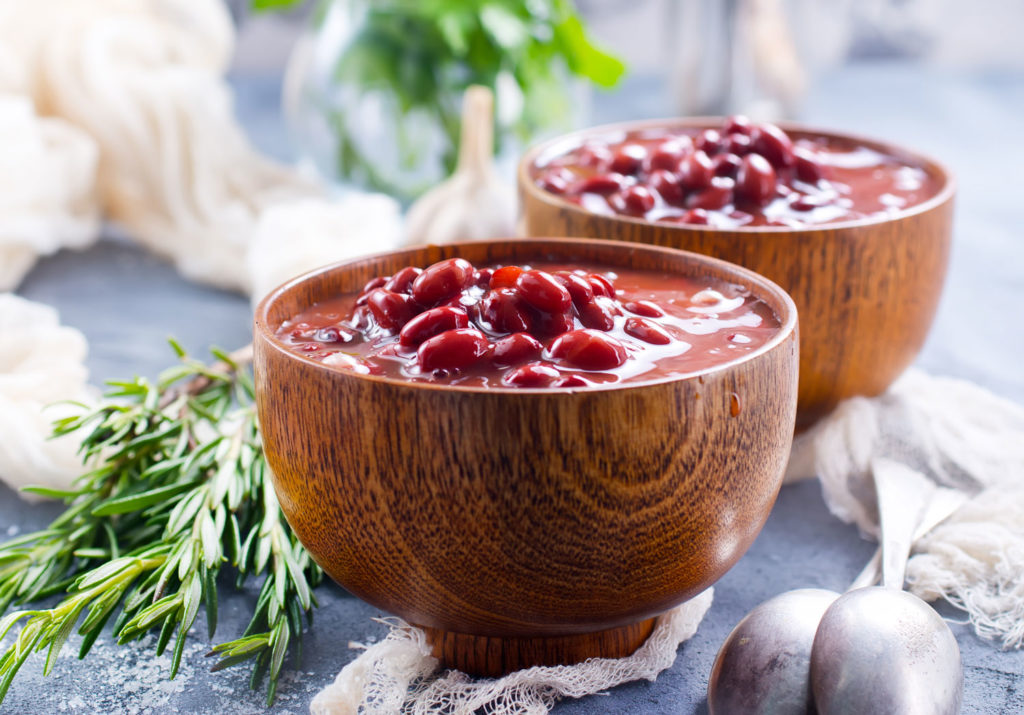
High-Fiber Foods Like Beans, Oats and Fruits
Fiber is a type of carbohydrate found in plant-based foods, and it’s categorized as soluble or insoluble.
Soluble fiber absorbs water and forms a gel that’s consumed by gut bacteria, says Alicia Romano, a specialized clinical dietitian at Tufts Medical Center in Boston and a spokesperson for the Academy of Nutrition and Dietetics. Meanwhile, insoluble fiber passes through your digestive tract largely intact and helps provide bulk to your stool. “This makes food pass more quickly through the GI tract, thus promoting regular bowel movements,” Romano says.
Both types of fiber help with gut health by assisting with digestion and preventing constipation. Eating high-fiber foods also helps protect you from gaining excess weight and developing chronic conditions, such as heart disease, type 2 diabetes, high blood pressure and some kinds of cancer, according to a review of studies in The Lancet.
Good sources of fiber include:
- Beans, dried peas and lentils
- Bran (oat and wheat)
- Dried fruits, such as prunes and raisins
- Foods made with whole grains, such as whole-grain bread, whole-grain cereal and whole-grain pasta
- Whole grains, such as barley, quinoa, bulgur and brown rice
- Fresh fruits, especially apples with skin, pears with skin, oranges, blueberries, raspberries, blackberries and strawberries
- Nuts
- Seeds
- Vegetables, especially artichokes, broccoli, green peas, winter squash, and white potatoes and sweet potatoes with skin
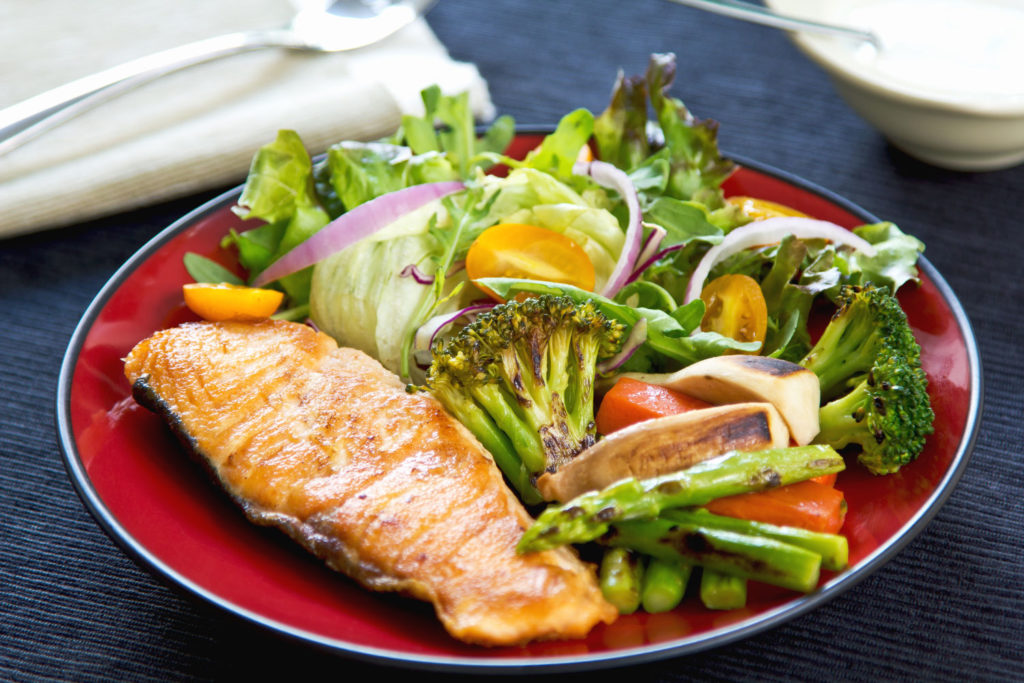
Anti-Inflammatory Foods
Inflammation occurs when your body releases white blood cells and other compounds to protect you from infection. This reaction benefits you when you actually have an infection, but sometimes your body goes into a type of inflammatory overdrive even when no infection exists, dispersing inflammatory chemicals such as cytokines when you don’t need them. This process can contribute to or worsen gastrointestinal conditions, including irritable bowel syndrome, ulcerative colitis and Crohn’s disease.
Anti-inflammatory foods contain nutrients, such as vitamins, minerals and omega-3 fatty acids, that can help cool down inflammation. “These play a role in the natural antioxidant and anti-inflammatory pathways of the body, which may also promote the health of the gut,” Romano says.
Helpful anti-inflammatory foods include:
- Fatty fish, such as salmon, sardines and anchovies
- Flax seeds
- Fruits, such as berries and grapes
- Vegetables, such as broccoli, peppers and tomatoes
- Walnuts
Filling your daily diet with a range of foods is an excellent way to boost your gut microbiome—and your health as a whole. An abundance of nutrients from a variety of foods is key to positively impacting your gut. The more varied the diet is as a whole, the more access the gut has to multitude of beneficial nutrients.
And don’t forget to drink plenty of water throughout the day. Water not only enables fiber to do its job properly in your gut, but also helps keep your digestive system—and the rest of your body—running smoothly. Adequate fluid intake is essential for the health of all organ systems, as well as the health of our gut.

COMMENTS